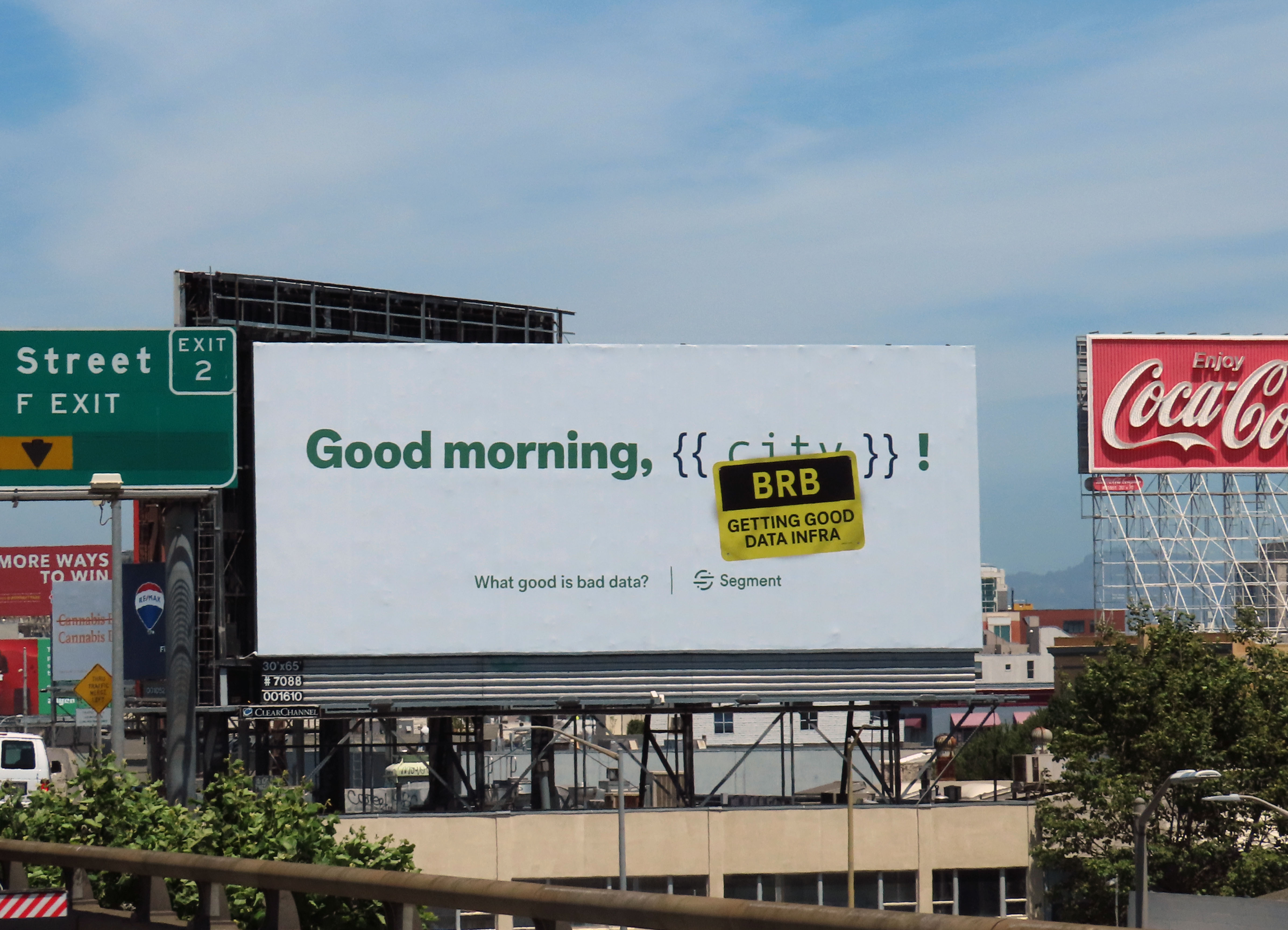Imagine you commute through San Francisco via the I-80E every day. Over the last several months, you might have noticed a billboard that did not seem quite right. And even worse, once you realized what was wrong…things only seemed to get messier.

Good morning…wait, what city are we in again?

One month later, still not populating correctly.

Acknowledging that we needed a moment to get the good data infrastructure in place.
It might have made you scratch your head, laugh, or even do a double-take. How could Segment get the city wrong? Why would we print “Good morning” on a static billboard that could be seen 24 hours a day? (We had one job!)
Well, there’s more. It didn’t just happen in San Francisco. These mixups found their way into billboards across Austin, New York, Los Angeles, Chicago, and five other major cities.

Actual location: Austin
Actual location: Los Angeles

Actual location: New York
In each case, we planned the mixup, and had a great time matching “rival” cities to each location. But what happens when a data mess of this caliber is unplanned? What happens when a business relies on bad data and ends up with a bunch of billboards greeting the wrong city?
It might not be as public as a billboard, but this sort of thing happens to businesses every single day. It happens because somewhere along the way the data they’re relying on has let them down. And using that bad data to influence real business decisions can lead to consequences much bigger than our amusing mixup.
It makes you wonder: what good is bad data?
Bad data is everywhere
It doesn’t take long to find. Check your email inbox right now and it’s almost a sure bet that you’ll find emails that call you by the wrong name, recommend finishing the purchase on something you literally just bought, or that clearly were meant for someone else. It’s (hopefully) not something the company directed your way on purpose. They simply relied on bad data…and things did not go as intended.
Bad data can exist in many different forms—it can be stale, inaccessible, untrustworthy—but it always leads to bad outcomes. There are serious consequences to trusting data gone bad. IBM estimates that bad data costs the US $3 trillion each year. Bad data caused Delta to cancel hundreds of flights last year and cost the company $150 million.
The consequences aren’t strictly financial—they also impact your brand. Customers increasingly want to do business with brands that know their name, their preferences, and can replicate great experiences across the web, in person, over the phone and email. If you’re not proactively addressing bad data, you’re at risk of becoming the next punchline on social media:

The irony of receiving an email about the GDPR that has bad data in it.
So, how do you avoid bad data?
Like everything in the universe, data tends toward chaos over time. If one product team at your company tracks “user_signup” and the other tracks “user_Signedup,” it won’t kill your business at first. But what happens when you have dozens of products and need to figure out how user signups are going overall? That simple question can take weeks to answer. And there’s a chance that your answer will still be wrong.
You need to prevent data from going bad starting on Day 1—and use technology to minimize the effort it takes to keep data in order as your business grows and changes.
Good data doesn’t just happen, it’s the result of investing the appropriate time and resources into maintaining it. Whether that means empowering a data wrangler or a team of data champions, you need someone at your company to proactively enforce the practices that lead to good data.
These practices include everyone working from the same data dictionary so that everything you track is standardized and easy to understand. It also means replacing the convoluted web of integrations between your marketing and analytics tools with something that makes it easy to track everything once and share the same data across all tools. It even means practices that help you know what data every tool has access to so you can filter and control which data goes where.
Good data is Segment data
Segment is the easiest way to empower your business to follow the practices that lead to good data. Our technology helps you collect all of your data through one API where it can be cleaned and standardized. It helps you enforce a common data dictionary and the standards that prevent bad data no matter how complex your business or organization gets. It helps you trust that you are informing your decisions and tools with the absolute best data you can.
Whether you’re a Fortune 500 or a fast-growing startup, you have a choice to make when it comes to what kind of data powers your business. You can have data that powers revenue-growing decisions. You can have data that powers marketing campaigns and personalization that works. You can have data that helps build delightful, five-star customer experiences.
Or not. You can have bad data that leads to wasted money, bad decisions, and embarrassing billboards. The choice is yours.

The State of Personalization 2023
Our annual look at how attitudes, preferences, and experiences with personalization have evolved over the past year.